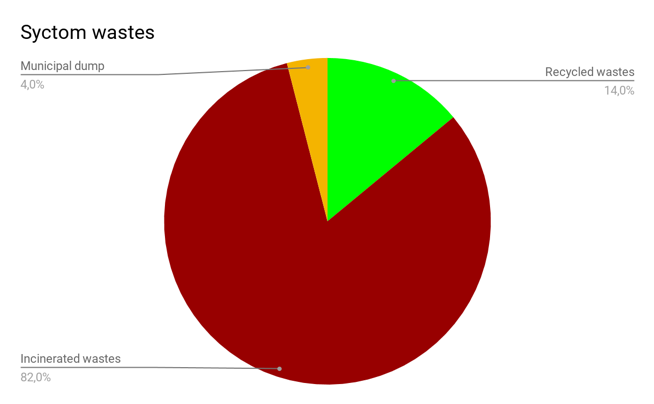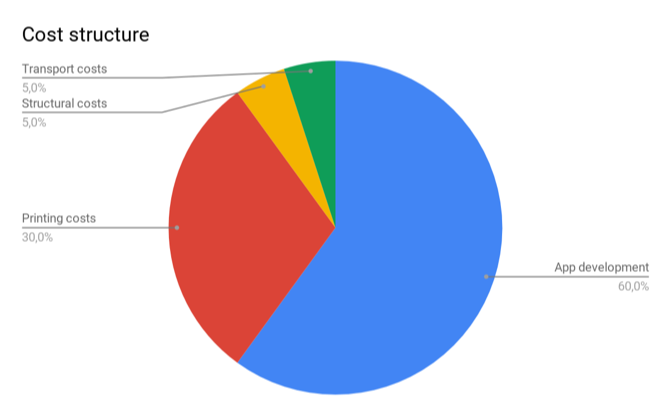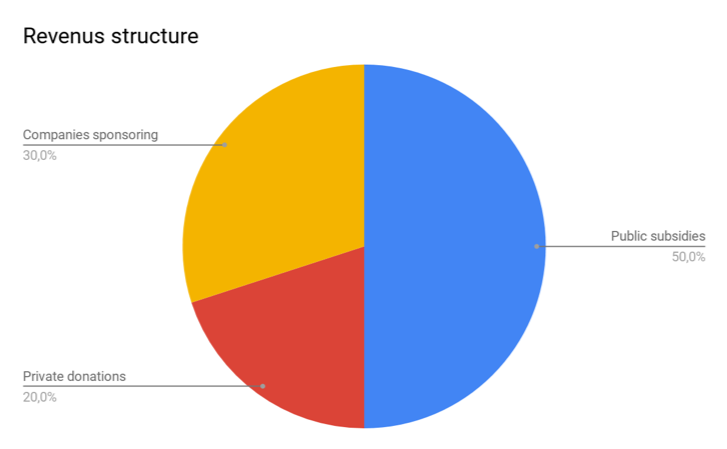Note of intent
Issue
We observed that the recycling ratio (recycled waste/total waste) was only about 18% where the national average is about 40% and the european one comes to 45%. The other analysis is that 18.7% of wastes thrown in the yellow dustbin aren’t correctly sorted: as a consequence, they aren’t recycled. Considering Syctom datas (Syctom is an intercommunal cooperation union in charge of domestic wastes treatment in Île-de-France), the majority of our trashes are incinerated which is the most polluting process due to fumes.

By not sorting well our wastes and adopting second-rate efficiency treatments, it destroys the environment and population health meanwhile we drain our natural resources. That is why we think it it crucial to improve the ability of Parisians to sort their wastes in order to increase the recycling rate. Considering this point, we wanted to create a solution to answer the following issue: How to raise Parisians’ awareness among recycling to Paris recycling rate, considering the fact that some non-recyclable wastes are thrown in sorting dustbin? The efficiency of our solution will come out as an increase of recycling rate in Paris. Another idea would be to make qualitative studies about Parisian’s recycling.
Our Concept
A. Description
We wanted to create micro-help communities to ease and promote recycling to a local scale by implementing an urban-environmental “scouting movement” for citizens of all ages. The best way to do it is to create an app which will provide informations about recycling good practices and about the life cycle of products, creating at the same time communities involved in recycling.
Finally, the idea of KIDS (Keep it damn simple) is born, a fun and educational app to promote recycling addressed to every citizen. Considering the location and its recycling habits, each user will be assigned to a community. The purpose will be to compete against other communities in order to become the greener one and all these informations will be pointed in the “green record” section.
To help communities increase their score, our app contains four other sections, starting with the “daily journal” one. The purpose of this section is to inform the user of its own recycling rate, making a distinction between the products he recycles. At the same time, he can scan his products to learn about their life cycle depending on its material or production methods for example.
With the “activities” section, we bring a playful dimension to KIDS. This is the place where weekly activities, public or private, will be listed allowing our users to take part into the ones they are interested in. This is the concrete part of our app as it brings informations about recycling by involving users into the recycle process. On the other hand, it is a way to socialize them in communities mindful of the crucial role of recycling.
We didn’t forget the theoretical dimension with the “Time to learn stuff” section. Staying very accessible and fun, it is the part where the user keeps up to date on environmental news and informations turned into “fun facts”. This section will also provide a “DIY” section to give ideas on how to reuse daily products.
Finally, the “Around you” section informs the user on its location and its belonging community. The map also indicates places where activities are organized around him, not forgetting the location of recycling bin around.
Our key activities will aim to federate a community around the common issue of recycling. The first step will be informational with the organisation of conferences and films screenings in order to sensitize to the subject and foster creativity in the recycling process. Then, set up competitions between school constitute a mainstake of our project because it is addressed to the next generation. In the one hand it makes the youngest aware of that issue and in the other, it constitutes an educational and playful way to learn them how recycle effectively. Thirdly, working with local companies in the frame of “jeux concours” is a good way to promote our application and boost recycling. For consumers, it consists in earning giveaway from a local company during special events rewarding the best recycler of the day.
B. How to implement ?
First of all, we will start to implement our project in a very local scale. We have to forget people that would eventually be eager to start using our app. The first category of people that we can target is the children from primary school to high school. It could be for them a way to compete each other in order to be the greenest one. In Paris, the 15th arrondissement has all the features that we are looking for to implement our app. In this neighborhood we will create partnerships with different schools and give our app a way to be part of the educational system. Touching the children we want also to target their parents. In each school we will organize through professors and directors some games and competition between classes, schools and neighborhoods. We really want to implement our app in the simplest way we can to make it practical and natural.
Thus we will start to implement the app in a few neighborhoods in Paris, the most dynamique ones and the youngest ones. We will also create partnerships with each Mairie d’arrondissement. It will be a way to receive public help and finance and benefit from their settled networks. Working with each maries will allow us to promote our app and organize physical activities in each neighborhood that will also promote the app. We want to take people from the street to the app and from the app to the street.
Market study
A. Customer segments
The first customer segment we can identify is children, starting in primary school. This young population may indeed be to young to consume by themselves, but it is important that they learn the right environmental gestures at the younger ages so it turns out to be almost instinctive when they’ll be in age to sort their wastes.
We also aim at targeting associations and youth movements (such as scoutism) committed to the city, since a lot of them promote environmental values. Sports and cultural associations would thus be relevant consumers.
College Student is also a major segment that has shown a lot of interest in environmental changes. This population is more and more aware of the urge of changing our habits. Since there is a lot of student initiative in Schools (e.g. environmental associations in most of the universities), we have every reason to think this part of the population would be extremely responsive to such a project.
Finally, the most important segment is consumers. They are at the origin of the creation of waste so they’re the firsts concerned by our application. Since most of the people are willing to sort their wastes but don’t know how or are even sometimes too lazy to do it, the incentives created by the application would encourage consumers to have a more responsible comportment.
B. Customer relationship
How to acquire customers :
As a platform to make people aware of environmental issues, we need to be coherent and limit to the maximum the use of print such as flyers. However, we can use our main resources – internet - as a first resource to elaborate a communication a marketing strategy.
The communication strategy on internet will be first through our several account on the main social media. Twitter, Instagram and Facebook will be an important platform quickly a large audience. Every social media has its particularity, the challenge, here will be to propose a different way to engage the conversations with our future customers. On Twitter, for instance, we will repost -retweet- the different results of the different neighborhood shared by other accounts. On Instagram, it will be more about posting pictures and interviews of actual actors, local citizens using the app and explaining the benefits for our planet. People can also send their videos talking about this project and using the hashtag [name of the app]. Indeed, we plan to work with local influencers as a first step to increase our visibility on social media.
Another way to target the audience and reach our first customer is to work on short and dynamic video, using a simple language to promote the app. We can consider working with experts of this kind of video such as the media Brut.
We will of course make a press release which outlines briefly all the main information and why this app is important today in our society and our short-term and long-term objectives. This document will be sent to all the local media, radio and newspapers and spread by them to gain customers.
Finally, we need to build a strong relationship with the local authority to gain their support, so they can also use their voices on their platform. Our main argument for them is the creation of an app that will federate the city around the benefit of recycling thanks to new technologies. We will insist on the fact that this is a good promotion for the city and personal interest.
How to retain customers:
The first thing that will help create a long term relationship with customers is that our application stands for something that most of the segment we target can identify with (which is environmental values).
Then, the fact that the application identifies neighborhood initiatives will show users how they benefit the society. Indeed, the “Green Record” section will contribute to strengthen the feeling of belonging to a community.
The application also have a great ability to keep its users through a personal service, offering a daily journal to each consumer, as well as a personalized offer of activities or events around them.
Finally, the gamification of the platform will help build consumer loyalty.
C. Our partners
Our key partners will be made of several actors at different scales. First of all, the most local scale will be each citizen who lives in the neighbourhoods where we want to begin our project. They will be our first priority in the design of our application. Our aim is that they can consider our app as a powerful help to know how to recycle, how to understand how their products will create new ones and how they can join other motivated people in this common goal.
At a second scale, we want to cooperate with some public organisations and movements that are locally well implanted. First of all, we think about all the public schools where we know that recycling is a a key point of ecological awareness for children. Public schools are therefore really good partners for us to raise awareness and to accept to show some concrete projects of how recycling is really important. Our app will offer these motivated teachers a practical and interactive learning platform to teach recycling to pupils. More practically, we also think of several young organisations such as the scouting movement or the city association for young people to be our partners. Indeed, they can support the project to the extent that they can do a “washing day” in the street, raise people’s awareness in the street or explain near a trash how to well recycle. We are also interested in giving a word to youth people as they are actors of tomorrow concerning environmental protection.
Thirdly, we would like to have the support of every mayor of each borough to launch our project. This partner is very important for us in so far as communication will be mainly through the municipality. They can also give incentive in order to be the best “recycling borough” of Paris. Many good externalities can result of their action : more people getting involved in the project communication, more links between ecological associations, a good political image of their borough in Paris and economic gains of a better recycling process.
Last but not least, we want to have, for each borough, one influencer of personality who can represent the place where he/she lives. It should be a well-known people, recognised in the borough, member of associations, or motivated citizen. He/she will bring us more visibility using its influence to motivate other citizens.
Financing plan
A. Our ressources
We will primarily rely upon public and private subsidies to get our project up and running. In terms of public subsidies, the Banque Publique d’Investissement (BPI) is prominent in helping start-ups by offering a myriad of financing solutions. The BPI is all the more interesting in that its mission is to prioritize ecologically responsible and socially innovative enterprises. Another public subsidy source would be the PM’up program, whose purpose is to sustain start-ups operating in the Ile-de-France and that seek to spread sustainable development and eco-responsible citizenship. A last component of public funding are the Credit Impot Recherche (CIR) and Credit Impot Innovation (CII), which are advantageous tax regimes for start-ups allowing to decrease fixed costs while increasing the funds that can be allocated to research and growth.
From the private side of funding, various venture capital (VC) funds exist that invest in new start-ups, while some are specialized in new ventures targeting sustainable development. We would also tap this source of funding to get our project started.
A second major source of funding would obviously be crowdsourcing through a widespread fundraising campaign. A Kickstarter campaign is very common for start-ups to raise their first funds, and with the right marketing and communications campaign this can give us a solid basis to start our activities.
In terms of know-how and skills that our team brings, we consider ourselves well-equipped to launch our app. Anaïs is a talented, creative designer thanks to her background in design before coming to Sciences Po. This will be very important when designing and launching our visual communications. In terms of communication, Marie and Baudouin will be a major asset thanks to their previous experience and their master in communication. Victoire, Vincent, Arnaud and Yves will bring major skills in business development, which will allow us to choose a strategic position and differentiate ourselves from the very start. Camille’s joint master in finance and law will further allow us to understand the legal aspect of our business.
In terms of material resources, the only type of resources used within the activities linked to our application will be products to be recycled and that will be the basis of all our activities.
B. Cost and revenue structure
As a non-profit organization, we have a special cost and revenue structure specific to start-ups.

Our main cost will be the development of our application as our entire solution relies on it. Even if we rely on pro-bono works, we will have at some steps of our development to pay some extra workers.
The other major part will be some printing costs in order to ensure communication around our app. The other part will be structural costs (energy during meetings) and transport costs.
Our revenue structure will be the following:

We will essentially rely upon public subsidies given by municipalities and all the challenges organized for innovative solutions as Startup weekend or BPI. Sponsoring offered by companies wanting to be part of this “cultural-changing” project will be our second source of revenue.
It will be completed with private donations coming from associations or project members.
SWOT analysis
A. Strength
The real strength of our app is to create communities federating people around recycling. More than a way to learn how to recycle right, it is an opportunity given to our users to meet people sharing the same interest about the protection of the environment. We also think the sharing of this duty is the most efficient way to raise awareness about the significance of recycling today.
An other aspect which strengthens our position in the market is that we didn’t forget about the playful aspect. The recycling process is often seen as a boring one and it was important for us to introduce a fun dimension in order to provide interest and entertainment to our users.
Finally, our solution relies on new technologies which makes it more accessible to the population. The diversity of activities and content is also the best way to reach all citizen, from primary schools to consumers.
B. Weaknesses
Despite of the diversity of our appl there is still a risk it won’t catch population’s attention. We cannot ignore the fact that people may be insensitive to our project and our concern. The second weakness is that we only rely upon external resources. Our project is not financially autonomous, which may jeopardize its durability.
C. Opportunities
Our major opportunity is the new tech development. We will benefit from these evolutions to ameliorate the functioning of our app. On the other hand, it allows us to get closer to the younger population knowing that young people are the future of our environmental transition.
D. Threats
One threat that we have is that because of the hyperinflation of apps in general, people are fed up with technology and do not believe anymore that technology can be useful for the preservation of the environment. People already use thousand of apps and do want to download one more app.




